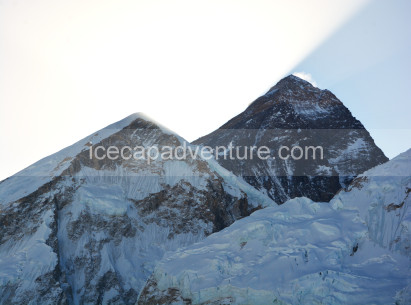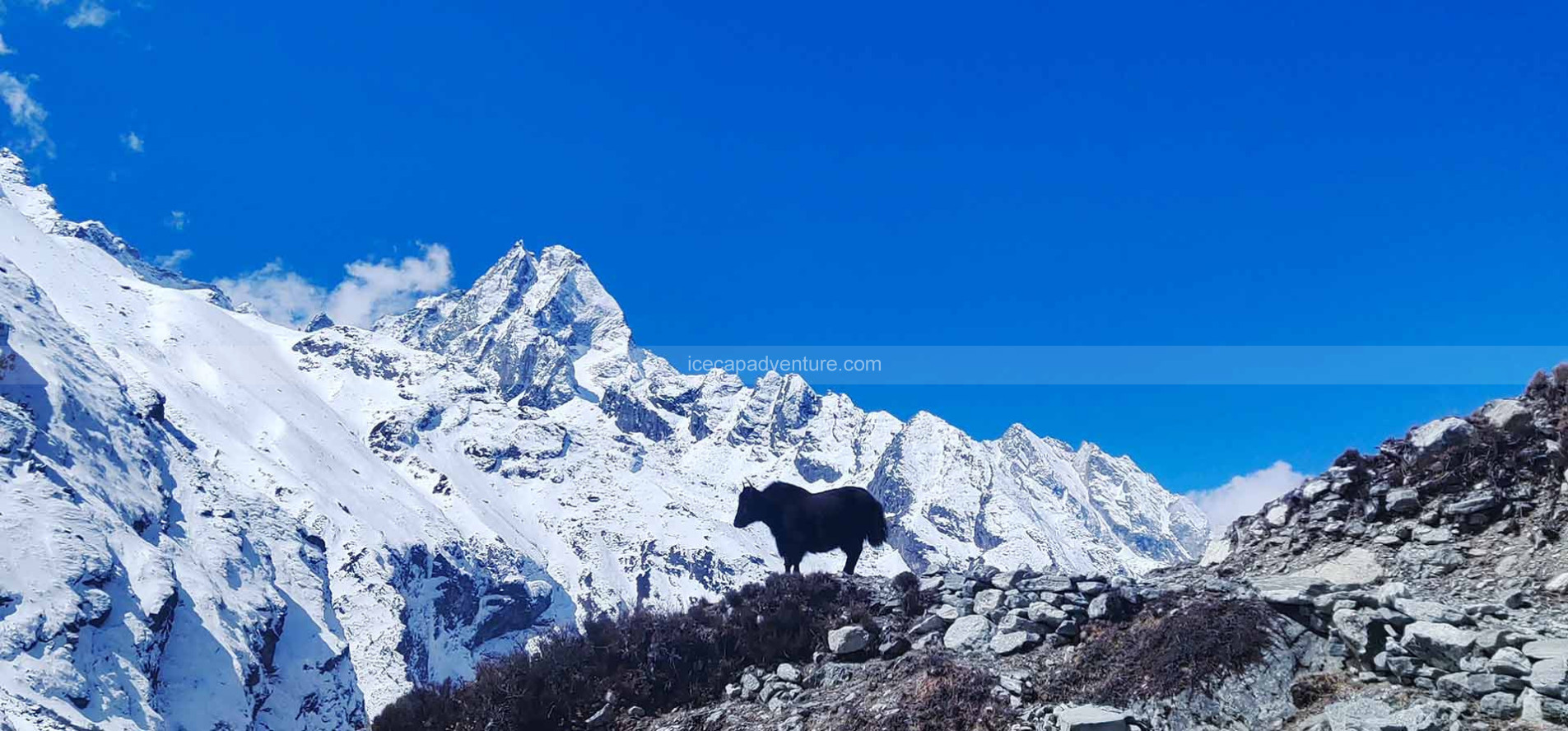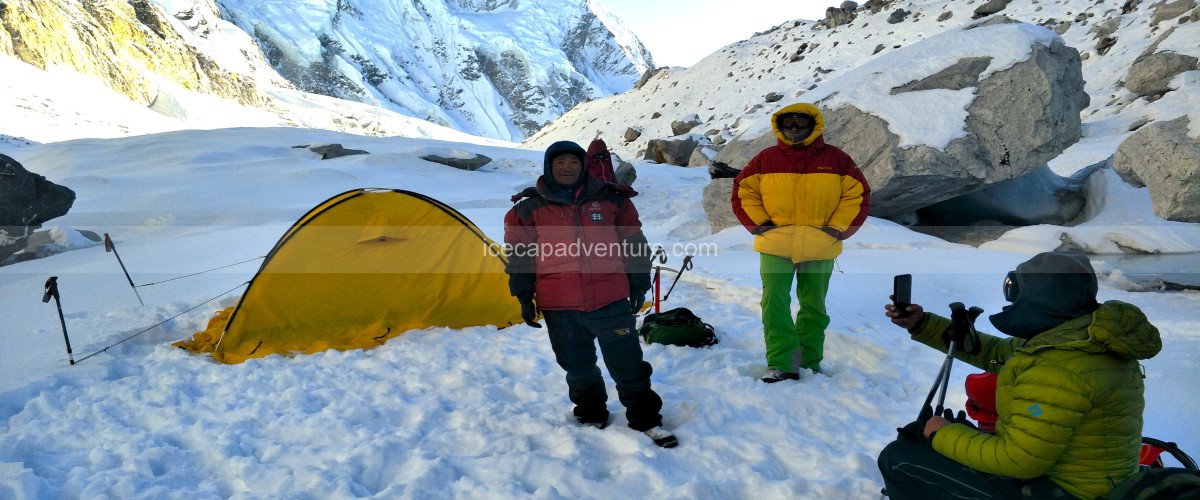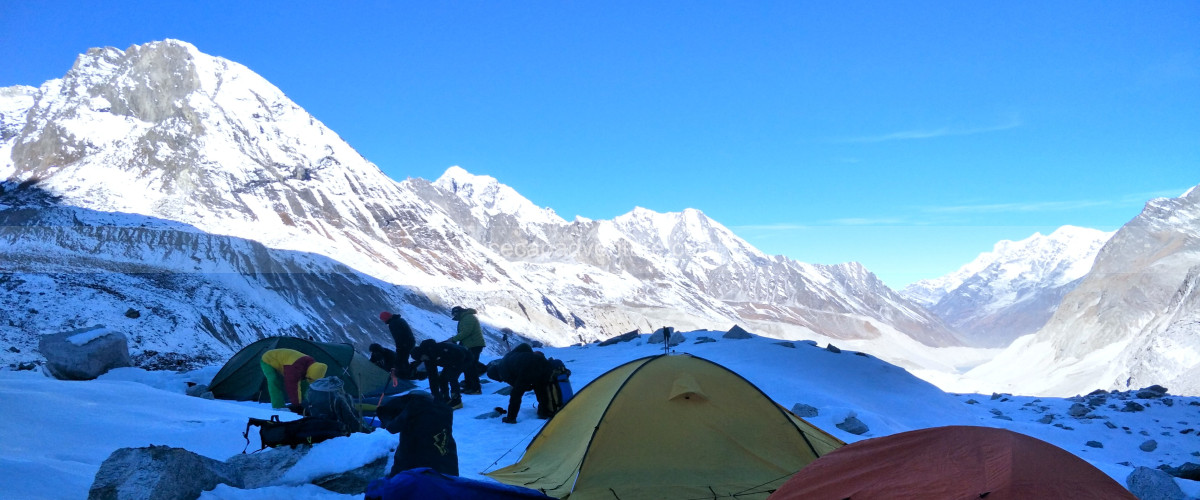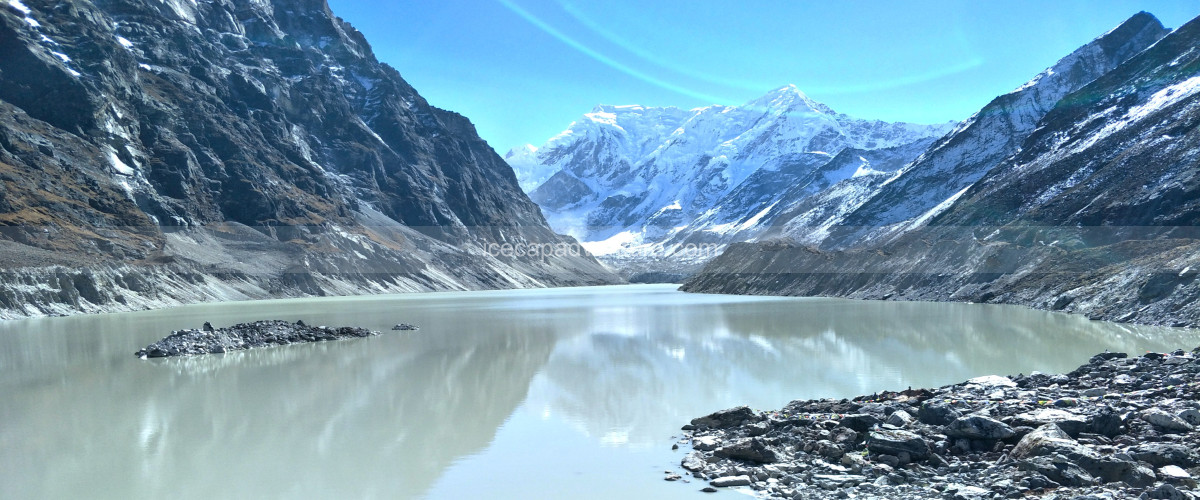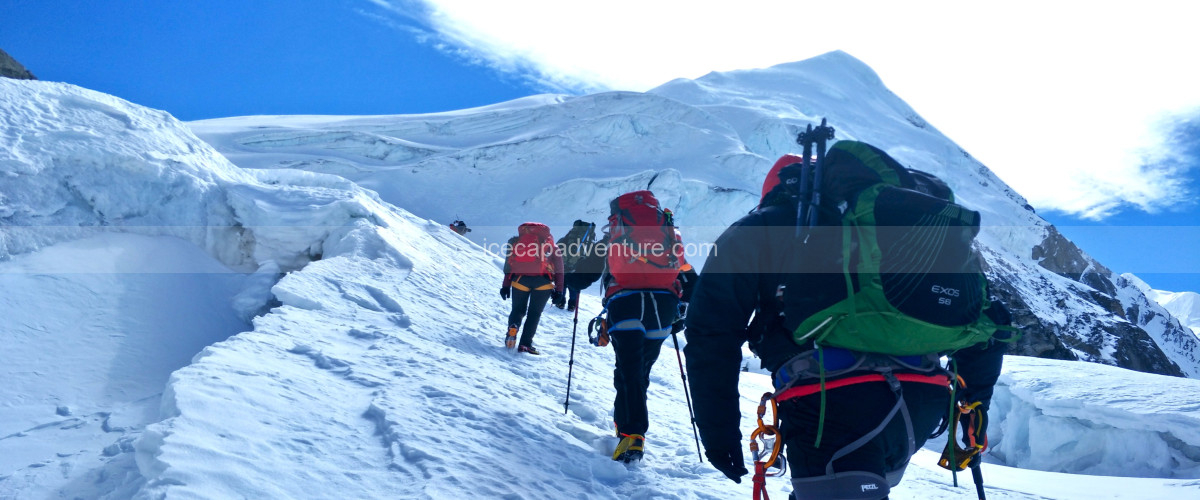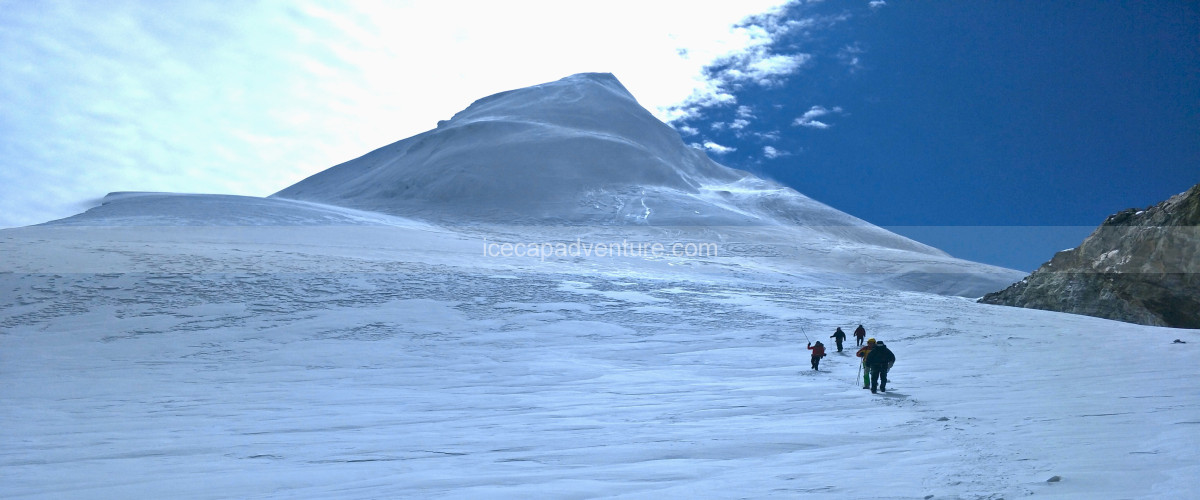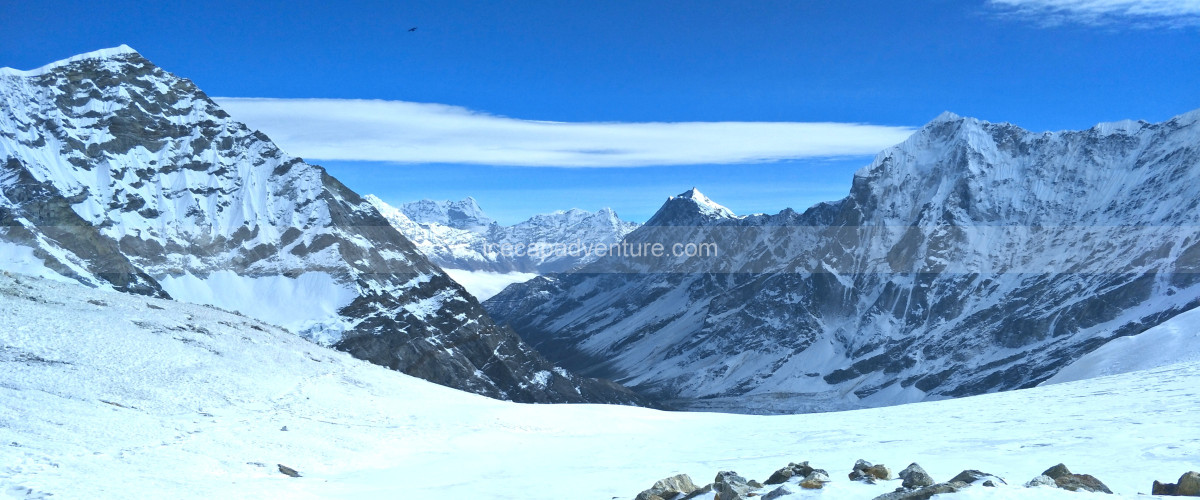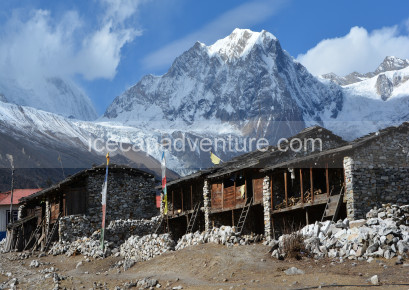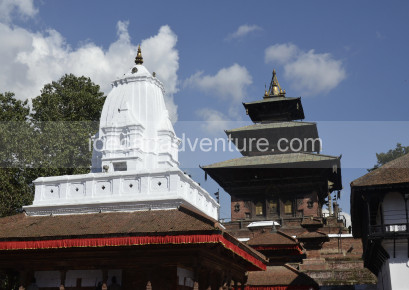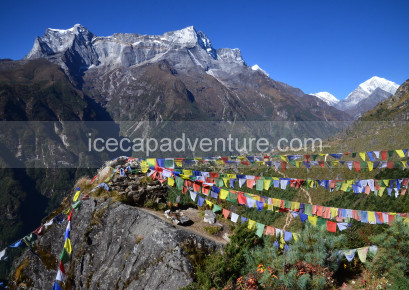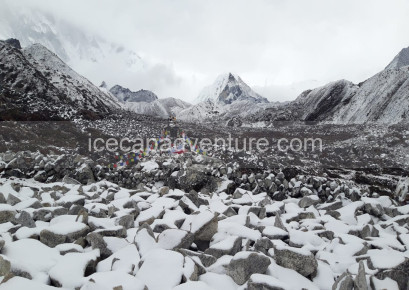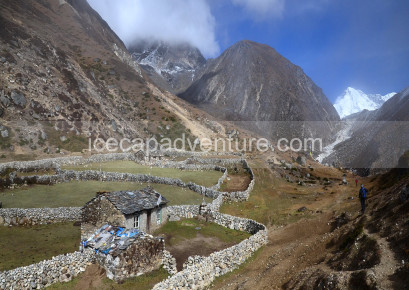.png)
.png)
.png)
.png)
.png)
.png)
.png)
Ramdung Peak Climbing – Himalayan Adventure Near Everest
Ramdung Peak, also called Ramdung Ri, is a spectacular trekking peak in the Khumbu region of Nepal, standing at 5,925 meters (19,442 ft). Known for its technical yet achievable climb, it offers breathtaking views of the Everest range, including iconic peaks such as Everest, Lhotse, Ama Dablam, and Cho Oyu. Ramdung is considered an ideal introduction to high-altitude mountaineering, making it perfect for trekkers seeking their first climbing experience in the Himalayas.
The climb combines a scenic trek with a technical summit ascent, allowing adventurers to experience snow and ice climbing, rope techniques, and glacier travel, all in a less crowded and serene environment compared to other peaks in the Everest region.
Duration & Difficulty
The Ramdung Peak Climbing itinerary generally lasts 12–15 days, including the trek to Base Camp, acclimatization, and the summit attempt. Classified as moderate, it is suitable for trekkers with good physical fitness and basic mountaineering skills. The summit climb involves steep snow slopes, rock scrambling, and glacier travel.
Route & Climbing Strategy
Most climbers follow the southwest ridge route, which involves:
-
Base Camp (5,000m): Preparation and acclimatization camp near the glacier.
-
High Camp (5,400–5,500m): Staging camp for the summit push.
-
Summit (5,925m): Technical ascent requiring crampons, ice axe, and fixed ropes.
Summit day offers spectacular 360° panoramic views of Everest, Lhotse, Nuptse, Ama Dablam, and the surrounding Khumbu peaks.
Best Time to Climb
The best seasons are spring (March–May) and autumn (September–November), when the weather is stable, skies are clear, and snow conditions are ideal for climbing. Monsoon season is not recommended due to heavy snowfall and poor visibility.
Accommodation & Meals
During the approach trek, accommodation is in tea houses or lodges with basic but comfortable facilities. At Base Camp and High Camp, climbers stay in tents, with meals prepared by expedition cooks. Nutrient-rich and high-calorie meals are served to support energy and stamina during the climb.
Permits & Regulations
Climbers must obtain a Ramdung Peak Climbing Permit from the Nepal Mountaineering Association (NMA) and a Sagarmatha National Park Permit for the Everest region. A TIMS card (Trekkers’ Information Management System) is also required. These permits ensure regulated and sustainable climbing in the Khumbu region.
Altitude & Safety
The summit altitude of 5,925 meters requires proper acclimatization to minimize the risk of Altitude Sickness (AMS). Climbers are accompanied by experienced Sherpa guides, who provide technical support and ensure safety on steep ice and snow sections. Travel insurance with helicopter evacuation coverage is highly recommended.
Responsible Climbing
Ramdung Peak expeditions follow eco-friendly and ethical practices, minimizing waste, avoiding environmental damage, and supporting local communities by employing Sherpas and local staff fairly.
Expedition Highlights:
-
Summit Ramdung Peak (5,925m): A technically rewarding Himalayan climb suitable for beginners to moderate climbers.
-
Panoramic Everest Views: Incredible vistas of Everest, Lhotse, Ama Dablam, and Cho Oyu.
-
Technical Climbing Experience: Practice glacier travel, ice climbing, and rope techniques.
-
Khumbu Cultural Experience: Trek through Sherpa villages, monasteries, and high alpine valleys.
-
Less Crowded Route: Enjoy a peaceful, less trafficked peak climb compared to other Everest region summits.
-
Professional Expedition Support: Guides, Sherpas, and cooks ensure a safe, successful expedition.
1
We will be waiting to welcome you at Tribhuvan International Airport, Kathmandu, where you will be greeted with a traditional Nepali flower garland to mark your arrival. After the warm welcome, we will drive you to your hotel—approximately 30 minutes during the day and 20 minutes at night.
Upon reaching the Hotel, you will be offered welcome drinks and biscuits, followed by the settlement of your rooms. Once settled, please join us back in the lobby or meeting hall for a briefing about your peak climbing program on Ramdung Peak Climbing, including an introduction to your guide and other relevant details.
After the briefing, you will have the opportunity to check your peak climbing equipment with your guide.
Note: If you arrive in Kathmandu at night, these activities will be scheduled for the following day after breakfast and meals.
.png)
.png)
.png)
.png)
2
Before embarking on the Ramdung Peak Climbing expedition, a day dedicated to shopping and preparation is essential to ensure you have all the necessary gear, supplies, and equipment for a safe and successful climb. This preparation phase is crucial for both trekking to Base Camp and the technical ascent of Ramdung Peak (5630m).
During this day, trekkers can purchase or check essential climbing and trekking gear, including insulated clothing, climbing boots, crampons, ice axes, harnesses, helmets, and gloves. Local shops in Kathmandu or nearby trekking hubs provide quality equipment and expert advice to ensure your gear meets high-altitude and safety standards.
Additionally, this day allows you to organize luggage, pack expedition kits, and verify permits and documentation. Guidance from your expedition team ensures that you are fully prepared physically, mentally, and logistically. For many, this preparation day is also an opportunity to learn about Ramdung Peak’s route, weather conditions, and acclimatization schedule, laying the groundwork for a safe and enjoyable climbing experience.
Highlights of the Day
-
Purchase or verify high-altitude trekking and climbing gear
-
Organize and pack expedition kits for Base Camp and summit attempt
-
Guidance on permits, documentation, and safety requirements
-
Learn about Ramdung Peak climbing route, acclimatization, and weather conditions
-
Mental and physical preparation for the upcoming expedition
.png)
.png)
.png)
.png)
3
The journey from Kathmandu to Jagat (1070m) marks the official start of the Ramdung Peak Climbing expedition, combining the thrill of adventure with scenic mountain landscapes. The day begins with a long but rewarding drive through winding roads, river valleys, and terraced hills, offering trekkers a first glimpse of the beautiful Manaslu and Langtang region foothills.
Leaving Kathmandu, the route follows the Trishuli River valley, passing small towns, roadside villages, and lush farmland. The drive takes approximately 8–9 hours, with several scenic stops along the way for photography, refreshments, and stretching legs. As you approach Jagat, the environment gradually transitions from subtropical lowlands to the rugged Himalayan foothills, signaling your entry into the trekking region.
Upon arrival in Jagat (1070m), trekkers settle into cozy teahouses or lodges, enjoy a warm meal, and prepare for the trek ahead. Jagat serves as a gateway village, where trekkers meet guides, porters, and fellow climbers, ensuring all logistics are in place before beginning the journey to higher altitudes.
Highlights of the Day
-
Scenic drive through Trishuli River valley and Himalayan foothills
-
Passing villages, terraced farmland, and river valleys
-
Opportunities for photography and short scenic stops
-
Arrival at Jagat (1070m), the starting point for the trek
-
Overnight stay in comfortable teahouses or lodges
.png)
.png)
.png)
.png)
4
The trek from Jagat to Simigaon (2000m) is the first full day on the trail and introduces trekkers to the stunning landscapes and vibrant culture of the Manaslu region. The route follows the Budhi Gandaki River valley, passing terraced fields, small villages, and traditional stone houses, giving trekkers a first taste of Nepalese mountain village life.
Leaving Jagat (1070m), the trail ascends gradually through forests of pine, bamboo, and rhododendron. Along the way, you’ll cross suspension bridges over glacial streams, navigate narrow trails carved into hillsides, and pass small villages where locals greet trekkers with warmth and hospitality. The journey offers excellent opportunities for photography and enjoying views of the surrounding hills and river valleys.
Arriving at Simigaon (2000m), trekkers are greeted by a cozy teahouse or lodge, perfect for resting after a day of moderate trekking. Simigaon is a quiet village that allows you to immerse yourself in local culture, prepare for the days ahead, and enjoy the serene environment of the lower Himalayan region.
Highlights of the Day
-
Gradual ascent through pine, bamboo, and rhododendron forests
-
Crossing suspension bridges and narrow riverside trails
-
Passing traditional mountain villages and observing local life
-
Scenic photography opportunities of river valleys and foothills
-
Overnight stay in Simigaon (2000m) teahouses or lodges
.png)
.png)
.png)
.png)
5
The trek from Simigaon to Dovan (2850m) takes you deeper into the Manaslu region, with steadily ascending trails offering breathtaking views of river valleys, forests, and distant peaks. This section is a wonderful introduction to higher-altitude trekking, combining natural beauty with the charm of remote mountain villages.
Leaving Simigaon (2000m), the trail gradually climbs through dense forests of rhododendron, pine, and oak, crossing streams and terraced farmlands along the way. Trekkers will pass traditional villages, where stone houses, mani walls, and prayer flags reflect the Tibetan Buddhist culture of the region. Several suspension bridges span the Budhi Gandaki and its tributaries, adding a touch of adventure to the day’s hike.
Arriving at Dovan (2850m), you’ll find a peaceful mountain settlement with cozy teahouses or lodges, perfect for rest and acclimatization. The village offers stunning views of surrounding ridges and Himalayan peaks, allowing trekkers to reflect on their progress and prepare for the higher altitudes ahead on the Ramdung Peak Climbing expedition.
Highlights of the Day
-
Gradual ascent through rhododendron, pine, and oak forests
-
Crossing streams and suspension bridges along the Budhi Gandaki
-
Passing traditional mountain villages with Tibetan Buddhist influences
-
Scenic viewpoints of valleys, ridges, and distant peaks
-
Overnight stay in Dovan (2850m) teahouses or lodges
.png)
.png)
.png)
.png)
6
The trek from Dovan to Beding (3692m) marks a significant step into high-altitude trekking on the Ramdung Peak Climbing expedition. The trail ascends steadily through alpine forests, river valleys, and traditional villages, giving trekkers their first true taste of the Himalayan environment and culture.
Leaving Dovan (2850m), the path winds through rhododendron, pine, and birch forests, crossing glacial streams and narrow ridges. The Budhi Gandaki Valley opens up to reveal snow-capped peaks and alpine landscapes, while traditional villages along the route showcase stone houses, mani walls, and prayer flags, reflecting the rich Tibetan Buddhist culture.
Beding (3692m) is a picturesque mountain village, surrounded by towering peaks and glaciers, making it an ideal location for rest, acclimatization, and photography. The cozy teahouses or lodges provide warm meals and comfortable rooms, allowing trekkers to recover from the day’s climb and prepare for the higher-altitude sections ahead.
Highlights of the Day
-
Steady ascent through alpine forests and high mountain valleys
-
Crossing streams and narrow ridges with Himalayan views
-
Passing traditional Tibetan Buddhist villages with prayer flags and mani walls
-
Stunning panoramic views of surrounding peaks and glaciers
-
Overnight stay in Beding (3692m) teahouses or lodges
.png)
.png)
.png)
.png)
7
A Rest and Exploration Day during the Ramdung Peak Climbing expedition is an essential part of acclimatization and preparation for higher altitudes. This day allows trekkers to recover physically, adjust to the thin mountain air, and explore the surrounding Himalayan environment before continuing toward Base Camp and the summit attempt.
While resting, trekkers can take short hikes around the village, venture to nearby ridges, or visit local monasteries and mani walls, gaining insight into the Tibetan Buddhist culture of the region. The exploration walks are designed to gradually increase altitude, helping the body adapt while offering breathtaking views of glaciers, peaks, and alpine valleys.
The village provides cozy teahouses or lodges with warm meals and comfortable rooms, allowing trekkers to relax, enjoy the serene mountain environment, and prepare mentally for the summit push. This day also offers opportunities for photography, journaling, or simply soaking in the remote beauty of the high Himalaya.
Highlights of the Day
-
Rest and recovery at high altitude for optimal acclimatization
-
Short exploratory hikes to nearby ridges, glaciers, or viewpoints
-
Experience local Tibetan Buddhist culture through monasteries and mani walls
-
Enjoy stunning panoramic Himalayan views
-
Preparation for the upcoming ascent of Ramdung Peak
.png)
.png)
.png)
.png)
8
The trek from Beding to Na Gaon (4180m) is a significant step toward the high-altitude zones of the Ramdung Peak Climbing expedition. The trail gradually ascends through alpine terrain, glacial streams, and rugged ridges, offering trekkers both breathtaking views and valuable acclimatization for the days ahead.
Leaving Beding (3692m), the path climbs steadily through rocky trails and sparse alpine vegetation. Along the route, trekkers cross small streams, navigate gentle moraines, and pass areas dotted with prayer flags, mani walls, and isolated stone huts, reflecting the Tibetan Buddhist influence in this remote region.
Na Gaon (4180m) is a quiet high-altitude settlement that provides a comfortable rest stop before moving further toward Base Camp. The village offers basic teahouse accommodation with warm meals, making it ideal for rest, acclimatization, and preparation for the higher climbs. The surrounding landscapes feature towering peaks, glaciers, and panoramic Himalayan vistas, providing both inspiration and motivation for the upcoming summit attempt.
Highlights of the Day
-
Gradual ascent through alpine terrain and rocky trails
-
Cross small streams and navigate moraines and high ridges
-
Experience Tibetan Buddhist culture with prayer flags and mani walls
-
Spectacular views of surrounding glaciers and Himalayan peaks
-
Overnight stay in Na Gaon (4180m) teahouses for acclimatization
.png)
.png)
.png)
.png)
9
The trek from Na Gaon to Ramdung Peak Base Camp (4700m) is a pivotal stage in the expedition, marking your entrance into the high alpine and glacial zones of the Himalaya. The trail ascends steadily through rocky ridges, moraines, and snow-kissed landscapes, offering trekkers spectacular panoramic views and crucial acclimatization before the summit push.
Leaving Na Gaon (4180m), the path climbs gradually along the glacial valley, passing streams and small icefalls. Trekkers will notice the dramatic change in landscape as forests give way to bare rock, loose scree, and sparse alpine vegetation. Prayer flags and small chortens dot the trail, highlighting the Tibetan Buddhist culture even in these remote high-altitude regions.
Arriving at Ramdung Peak Base Camp (4700m), you are surrounded by towering peaks, glaciers, and the icy slopes that lead toward the summit. The Base Camp provides a rugged but functional resting point, where climbers can prepare gear, rest, and acclimatize for the challenging ascent ahead. The scenery here is truly awe-inspiring, offering a sense of achievement and anticipation for the summit attempt.
Highlights of the Day
-
Steady ascent through glacial valleys, rocky ridges, and alpine terrain
-
Observation of high-altitude landscapes and sparse alpine vegetation
-
Tibetan Buddhist cultural markers such as prayer flags and chortens
-
Arrival at Ramdung Peak Base Camp (4700m) for acclimatization and preparation
-
Stunning views of surrounding peaks and glaciers
.png)
.png)
.png)
.png)
10
The Preparation and Climbing Lesson Day is an essential part of the Ramdung Peak Climbing expedition, designed to ensure that climbers are fully equipped, skilled, and confident before attempting the summit. This day focuses on technical training, gear familiarization, and high-altitude preparation, making it a crucial step in a safe and successful climb.
At Ramdung Peak Base Camp (4700m), experienced guides conduct practical climbing lessons, covering key skills such as using crampons, ice axes, ropes, harnesses, and belaying techniques. Trekkers practice ascending and descending on ice and snow, self-arrest maneuvers, and safety procedures, all under expert supervision.
In addition to technical training, this day is used to organize climbing gear, check personal equipment, and review the summit route. Climbers also focus on acclimatization, performing short hikes around Base Camp or nearby ridges to help the body adapt to higher altitudes. The day provides both mental and physical preparation, ensuring climbers feel confident, safe, and ready for the challenging ascent of Ramdung Peak (5630m).
Highlights of the Day
-
Practical climbing lessons on ice, snow, and rocky terrain
-
Training in the use of crampons, ice axes, ropes, and harnesses
-
Review and organization of personal and expedition gear
-
Short acclimatization hikes around Base Camp
-
Preparation for a safe and successful summit attempt
.png)
.png)
.png)
.png)
11
The journey from Ramdung Peak Base Camp (4700m) to High Camp I (5000m) is the first major step into the high-alpine climbing zone, marking the transition from trekking to serious mountaineering. This day focuses on gradual altitude gain, acclimatization, and route familiarization, setting the stage for the summit attempt.
Leaving Base Camp, the trail climbs steadily through rocky slopes, loose scree, and alpine ridges, with dramatic views of glaciers and surrounding peaks. Climbers will encounter prayer flags, small cairns, and occasional ice patches, all while practicing careful footwork and pacing to maintain energy at high altitude.
Arriving at High Camp I (5000m), climbers are rewarded with a stunning panoramic view of Ramdung Peak, its glaciers, and neighboring Himalayan mountains. This camp serves as a critical acclimatization and staging point, allowing climbers to rest, hydrate, and mentally prepare for the higher camps and the summit push.
Highlights of the Day
-
Steady ascent through rocky slopes, scree, and alpine terrain
-
Observation of glaciers, high peaks, and panoramic Himalayan landscapes
-
Exposure to prayer flags and high-altitude cultural markers
-
Arrival at High Camp I (5000m) for acclimatization and rest
-
Preparation for further ascent to High Camp II and the summit
.png)
.png)
.png)
.png)
12
The trek from High Camp I (5000m) to High Camp II (5600m) is the final step of acclimatization and preparation before the summit push of Ramdung Peak (5630m). This stage involves high-alpine climbing, careful navigation of glaciers and rocky slopes, and exposure to extreme altitude, making it both challenging and rewarding.
Leaving High Camp I, climbers ascend along steep scree, moraine trails, and glacial ridges, with snow and ice sections that require careful attention. The trail offers breathtaking close-up views of Ramdung Peak, surrounding glaciers, and Himalayan ridges, emphasizing the remote and pristine nature of this high-altitude environment.
Arriving at High Camp II (5600m), climbers find a strategic campsite for rest, hydration, and mental preparation for the summit attempt. The camp provides spectacular views of the peak, snowfields, and icy ridges, reinforcing the sense of achievement and anticipation for the climb ahead. Climbers focus on light exercises, gear checks, and acclimatization to maximize their chances for a safe summit.
Highlights of the Day
-
Steep ascent through scree, moraine, and glacial ridges
-
Exposure to high-alpine terrain with snow and ice sections
-
Spectacular panoramic views of Ramdung Peak and surrounding glaciers
-
Arrival at High Camp II (5600m) for final acclimatization
-
Preparation for the summit push to Ramdung Peak (5630m)
.png)
.png)
.png)
.png)
13
Today is the most anticipated and challenging day of the entire Ramdung Peak Climbing expedition — the summit day. From High Camp II (5600m), climbers make their final ascent to the summit of Ramdung Peak (5930m), a stunning vantage point in the Rolwaling Valley that offers panoramic Himalayan views and a true sense of achievement.
The climb begins early in the morning, often before dawn, to take advantage of firm snow conditions and calm weather. The route ascends gradually over snow slopes, ice ridges, and crevasses, requiring the use of crampons, ropes, and ice axes under the guidance of experienced climbing Sherpas. As you climb higher, the air thins, but the sight of towering peaks such as Gaurishankar, Melungtse, and even Everest in the distance inspires every step.
Reaching the summit of Ramdung Peak (5930m) is a truly unforgettable moment — standing on a Himalayan peak surrounded by snow-capped giants, you’ll feel the deep satisfaction of effort, courage, and perseverance. After celebrating and taking photos at the summit, the descent follows the same route back to Base Camp (4700m), where a warm meal and well-deserved rest await after an exhilarating and long day in the mountains.
Highlights of the Day
-
Early morning summit push to Ramdung Peak (5930m)
-
Technical climb over snow slopes, ridges, and icy sections
-
Breathtaking 360° views of Gaurishankar, Melungtse, Everest, and surrounding peaks
-
Sense of achievement standing atop a Himalayan peak
-
Descent back to Base Camp (4700m) for rest and celebration
.png)
.png)
.png)
.png)
14
After the thrilling summit of Ramdung Peak (5930m), today’s journey from Base Camp (4700m) to Kabug (Tsho Rolpa Lake, 4540m) offers a more relaxed yet incredibly scenic trek through the heart of the Rolwaling Valley. This stage showcases some of the most breathtaking glacial landscapes in the region, with opportunities to unwind, reflect, and absorb the beauty of the high Himalaya.
The trail descends gradually from Base Camp, winding through rocky moraines, glacial streams, and snow-fed valleys. The route provides stunning views of Tsho Rolpa Lake, one of Nepal’s largest glacial lakes, shimmering beneath towering snow peaks. Along the way, trekkers may encounter grazing yaks and pass stone-built shepherd huts, adding a touch of cultural charm to the wild terrain.
Arriving at Kabug (4540m) near the shores of Tsho Rolpa Lake, you’ll be surrounded by serene turquoise waters and panoramic views of the surrounding peaks. The area is a perfect spot for photography and relaxation after the demanding climb. The evening is spent enjoying the quiet beauty of the high-altitude lake, with the reflection of glaciers and stars on the still water — an unforgettable Himalayan experience.
Highlights of the Day
-
Scenic descent through glacial valleys and moraines
-
Stunning views of Tsho Rolpa Lake (4540m), one of Nepal’s largest glacial lakes
-
Observation of snow peaks, glaciers, and alpine wildlife
-
Encounter yak herders and stone shelters along the trail
-
Peaceful evening at Kabug near the lake, perfect for rest and reflection
.png)
.png)
.png)
.png)
15
After spending a peaceful night beside the magnificent Tsho Rolpa Lake (4540m), today’s trek descends from Kabug back to Beding (3692m) — one of the largest and most charming villages in the Rolwaling Valley. This journey offers a perfect mix of glacial scenery, alpine landscapes, and cultural immersion, making it both rejuvenating and picturesque.
The trail begins with a gentle descent along the glacial moraine, with stunning views of the lake, snow-capped peaks, and icy ridges in the early morning light. As you continue downhill, the terrain gradually transitions into lush alpine meadows and rhododendron forests, accompanied by the sound of distant waterfalls and the Rolwaling River flowing below.
Upon reaching Beding (3692m), trekkers are welcomed by warm hospitality, traditional stone houses, and Buddhist prayer flags fluttering in the mountain breeze. It’s a perfect place to rest and recover after the demanding climbing days, enjoy a hearty meal in a cozy teahouse, and reconnect with the friendly local Sherpa and Tamang communities that call this valley home.
Highlights of the Day
-
Scenic descent from glacial terrain to alpine meadows and forests
-
Last mesmerizing views of Tsho Rolpa Lake and surrounding glaciers
-
Experience the peaceful beauty of the Rolwaling Valley
-
Interaction with local villagers and Buddhist cultural sites
-
Comfortable rest and recovery at Beding (3692m)
.png)
.png)
.png)
.png)
16
Today’s journey from Beding (3692m) to Simi Gaon (2850m) takes you through one of the most beautiful and culturally rich sections of the Rolwaling Valley. After days in the high alpine and glacial zones, this descent feels refreshingly lush — filled with forests, waterfalls, and terraced hillsides that bring you closer to the foothills of the Himalayas.
The trail begins with a gentle downhill walk along the Rolwaling Khola (River), passing through rhododendron and pine forests alive with birdsong. Along the way, you’ll come across small herder settlements, Mani walls, and fluttering prayer flags, reminders of the valley’s deep Buddhist roots. The route provides magnificent views of Gaurishankar Himal (7134m), one of the region’s most sacred peaks, standing majestically over the valley.
As you approach Simi Gaon (2850m), the landscape opens into terraced farmland and charming Sherpa and Tamang villages. The village sits beautifully on a ridge, offering panoramic views of the surrounding mountains and valleys. It’s the perfect spot to enjoy a quiet evening, reflecting on your journey through the higher Himalayas and the rewarding experiences of Ramdung Peak.
Highlights of the Day
-
Scenic descent through dense rhododendron and pine forests
-
Serene walk along the Rolwaling Khola River
-
Spectacular views of Gaurishankar Himal (7134m)
-
Encounters with local Sherpa and Tamang communities
-
Peaceful overnight stay in the traditional village of Simi Gaon
.png)
.png)
.png)
.png)
17
Today’s trek from Simigaon (2850m) to Jagat (1070m) marks your gradual descent from the high mountain landscapes of Rolwaling back toward the lush, subtropical valleys. The change in scenery is remarkable — from alpine forests and cool breezes to warm hillsides covered in terraced fields, banana trees, and cardamom farms.
The trail begins with a steady descent through dense rhododendron, pine, and bamboo forests, offering glimpses of waterfalls cascading down rocky cliffs. As you move lower, the path winds through small farming villages, where you can observe traditional rural life and the warm smiles of locals going about their day. The soothing sound of the Rolwaling Khola River accompanies much of the walk, reminding you of the journey’s close connection with nature.
Approaching Jagat (1070m), you’ll notice the environment becoming more tropical — the air warmer, the vegetation greener, and the villages busier. Jagat serves as a welcoming stopover for trekkers, featuring comfortable teahouses and a lively atmosphere after days spent in remote high-altitude terrain. It’s the perfect place to rest, reflect, and celebrate the successful completion of your incredible Himalayan adventure.
Highlights of the Day
-
Beautiful descent from alpine to subtropical landscapes
-
Walk through rhododendron, bamboo, and pine forests
-
Refreshing views of cascading waterfalls and river valleys
-
Encounters with friendly local villagers and terraced farms
-
Arrival at Jagat (1070m) — gateway to the lowlands
.png)
.png)
.png)
.png)
18
Today marks the final leg of your Ramdung Peak Climbing adventure, as you leave the peaceful mountain village of Jagat (1070m) and drive back to Kathmandu (1350m). After days of trekking through remote valleys and towering Himalayan peaks, this journey offers a chance to sit back, relax, and watch the diverse beauty of Nepal unfold through the window.
The drive begins on a winding mountain road that follows the Rolwaling Khola River, gradually merging with the Sun Koshi River valley. Along the way, you’ll pass through charming hill towns, terraced farmlands, and green forested ridges, where local life thrives in the foothills. The road then joins the Arniko Highway, connecting the quiet countryside to the lively capital.
As you approach Kathmandu, the scenery shifts from tranquil rural settings to the colorful chaos of the city — a blend of ancient temples, bustling streets, and warm hospitality. Once you arrive, you’ll be transferred to your hotel, where a hot shower, comfortable bed, and perhaps a celebratory dinner await. It’s the perfect moment to reflect on your unforgettable Himalayan climbing and trekking experience.
Highlights of the Day
-
Scenic drive through lush hills, terraced fields, and riverside valleys
-
Passing local villages and observing rural Nepali lifestyle
-
Enjoying the beautiful transition from mountains to city
-
Comfortable return to Kathmandu’s vibrant atmosphere
-
Reflection on the memorable Ramdung Peak expedition
.png)
.png)
.png)
.png)
19
After days of trekking and climbing in the remote Himalayas, today is your well-deserved rest and shopping day in Kathmandu. This is the perfect time to unwind, rejuvenate, and soak in the charm of Nepal’s vibrant capital city before your journey home.
You can start the morning with a leisurely breakfast at your hotel, followed by a relaxing stroll through the city’s lively streets. Popular areas like Thamel, Ason Bazaar, and Durbar Marg are filled with colorful shops, handicrafts, trekking gear stores, and souvenir stalls, where you can find everything from handwoven pashminas to traditional Nepali jewelry and thanka paintings.
For those interested in culture, a visit to nearby UNESCO World Heritage Sites such as Swayambhunath (Monkey Temple), Pashupatinath Temple, or Boudhanath Stupa offers a glimpse into Nepal’s spiritual and architectural heritage. In the evening, you might choose to celebrate your successful Ramdung Peak expedition with a delicious farewell dinner featuring Nepali or international cuisine at one of Kathmandu’s cozy restaurants.
Highlights of the Day
-
Relax and recover after a long mountain expedition
-
Explore Kathmandu’s vibrant streets, local markets, and temples
-
Shop for souvenirs, handicrafts, and trekking gear
-
Visit UNESCO World Heritage cultural landmarks
-
Enjoy a farewell dinner and celebration in the city
.png)
.png)
.png)
.png)
20
Your incredible Ramdung Peak Climbing adventure comes to a close today. After an early breakfast, you’ll be transferred to Tribhuvan International Airport for your onward flight, carrying with you a heart full of memories, breathtaking mountain images, and the spirit of the Himalayas.
As you make your way through the bustling streets of Kathmandu, it’s a time for reflection — remembering the serene trails of the Rolwaling Valley, the shimmering beauty of Tsho Rolpa Lake, and the proud moment of standing atop Ramdung Peak (5930m). Every challenge, every sunrise, and every warm smile from the locals has become part of your unforgettable Himalayan story.
Whether you’re heading home or continuing your travels elsewhere, Nepal’s rich culture, natural beauty, and heartfelt hospitality will surely stay with you. As they say, “Once is not enough” — and many adventurers find themselves returning again to explore new corners of this majestic mountain nation.
Highlights of the Day
-
Final breakfast in Kathmandu before departure
-
Airport transfer to Tribhuvan International Airport
-
Reflect on your Himalayan journey and climbing achievements
-
Farewell to the land of the mountains and warm-hearted people
-
Promise to return for another adventure in Nepal
.png)
.png)

Didn’t find what you were looking for?
So why not plan your own trip. It takes only 2 minutes.- Airport Pick up and transfers to hotel and briefings with tea and biscuits in Kathmandu.
- All accommodation hotel in Kathmandu and trekking.
- Full board meal such as breakfast, Lunch and dinner during the trekking and climbing.
- Properly 3 times tea and coffee whatever hot drink available.
- Garbage Management and Garbage Disposal Fee.
- Government Lesion officer with his daily wages, equipment, food, insurance and both way airfare.
- Freshly cooked meals (Breakfast, Lunch & Dinner): Continental, Nepali, Indian and Chinese with hot drinks, Tea and Coffee.
- Experienced Base Camp Sirdar, Manager, Cook, Camp-2 Cook and Kitchen helpers.
- All transportation with AC deluxe from the starting to ending points of the trip.
- Walkie-Talkie for communicating from Base Camp to Mountain and Mountain to Base Camp.
- Experience professional climbing / trekking guide, sub guide and porters.
- Full insurance for staff during the trip.
- All climbing permits and trekking permit whatever needed.
- Down Sleeping bag (-20), must be returned after completion of trek.
- First Aid Kit for staff
- Government Taxes and Company Service Charge.
- Peak summit certificate after the successful summit of the peak.
- All international flight tickets, and Nepal entry visa fees.
- Lunch and dinner in Kathmandu.
- Personal Expenses: Phone calls, laundry, alcoholic beverages, hard drinks beverages.
- Personal Travel Insurance and High-Altitude Insurance (Accident, Medical and Emergency Rescue Evacuation)
- Personal climbing equipment and insurance.
- Drone & Special filming permit
- Extra night hotel in Kathmandu if arriving late or early departure than scheduled itinerary.
- Personal tips for trekking staff.

✅ Clothing
-
Base Layers (Thermal Tops & Bottoms)
-
Trekking Shirts (Long & Short Sleeves)
-
Fleece Jacket / Warm Mid-layer – For insulation.
-
Down Jacket – Essential for nights above 3,500m.
-
Waterproof & Windproof Jacket (with hood).
-
Trekking Pants (lightweight, quick-drying).
-
Warm Trekking Pants (for high altitude).
-
Waterproof Pants (for rain/snow).
-
Underwear – Comfortable, quick-dry.
-
Sports Bras (for women).
✅ Head & Hand Wear
-
Warm Hat / Beanie and Sun Hat / Cap.
-
Buff / Neck Gaiter / Scarf.
-
Sunglasses and Gloves 2 pairs
✅ Footwear
-
Trekking Boots – Sturdy, waterproof, broken-in.
-
Lightweight Shoes / Sandals – For camp/teahouse.
-
Warm Trekking Socks – At least 4–5 pairs.
✅ Sleeping & Bags
-
Sleeping Bag (Down -15°C) and Liner.
-
Duffel Bag (carried by porter).
-
Daypack (30–40L) – For personal items.
-
Rain Cover for Backpack.
✅ Trekking Gear
-
Trekking Poles & Gaiters – For snow or muddy.
-
Headlamp (with extra batteries).
-
Water Bottles (2–3 liters) and Water Purifications.
-
Personal First Aid Kit
-
Snacks / Energy Bars / Dry Fruits.
✅ Accessories & Personal Items
-
Sunscreen (SPF 30–50) and Lip Balm with SPF.
-
Toiletries and Hand Sanitizer.
-
Towel (quick-dry) and Toilet Paper
-
Camera / Power Bank / Solar Charger.
✅ Documents & Money
-
Valid Passport and Visa.
-
Travel Insurance (cover high-altitude & helicopter rescue).
-
Cash (Nepali Rupees) – For personal expenses.
Good to Know – Ramdung Peak Climbing
-
Best Seasons to Climb:
The Ramdung Peak Climb (5,925m) is best undertaken in spring (March–May) and autumn (September–November). These seasons offer clear skies, moderate temperatures, and stable weather conditions. The winter months are very cold and snowy, while the monsoon (June–August) brings rain, cloud cover, and limited visibility. -
Altitude Awareness:
Standing at 5,925 meters, Ramdung Peak requires proper acclimatization to prevent acute mountain sickness (AMS). Trekkers should plan gradual ascents and take rest days in places like Beding or Na Village before the climb. -
Physical Fitness:
The climb is moderate to challenging, suitable for trekkers in good physical condition with some previous trekking or basic climbing experience. Daily walking or climbing takes 5–7 hours, including steep trails and glacial terrain. -
Permits Required:
Climbers need a Ramdung Peak Climbing Permit, along with Gaurishankar Conservation Area Permit (GCAP) and a TIMS card. These are arranged through registered trekking or expedition companies. -
Accommodation and Meals:
Along the trekking route, accommodation is in local teahouses or lodges, while Base Camp and High Camp use tents. Meals include traditional Nepali dal bhat, soups, noodles, rice, and energy snacks. Food choices become limited at higher altitudes. -
Drinking Water:
Bottled water and boiled water are available in lower villages. Higher up, water is melted from snow or collected from streams, so carrying a reusable bottle and purification tablets or filters is essential. -
Packing and Gears:
Essential gear includes trekking boots, crampons, ice axe, harness, helmet, down jacket, gloves, warm layered clothing, trekking poles, sleeping bag (-15°C), sunglasses, sunscreen, headlamp, and personal first aid kit. Technical climbing gear is required for the final summit push. -
Transportation and Route:
The climb begins with a drive from Kathmandu to Gonggar or Jagat, followed by trekking through Simigaun, Beding, and Na villages to reach Ramdung Base Camp. The route passes through lush valleys, glaciers, and alpine landscapes before the summit attempt. -
Travel Insurance:
Comprehensive high-altitude trekking and climbing insurance is necessary, covering medical emergencies, helicopter rescue, and climbing-related risks. -
Connectivity and Charging:
Mobile networks are available in lower villages, but there is no signal or electricity at higher camps. Carrying solar chargers or power banks is recommended. -
Highlight Experience:
The Ramdung Peak Climb offers an exciting Himalayan adventure in the Rolwaling Valley, with breathtaking views of Gaurishankar, Melungtse, and Tashi Lapcha Pass. It’s ideal for adventurous trekkers seeking a remote, less-crowded peak that combines cultural richness, scenic beauty, and moderate mountaineering challenge.

